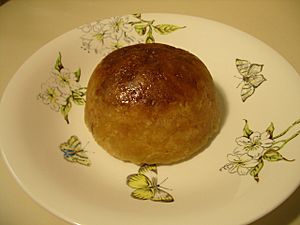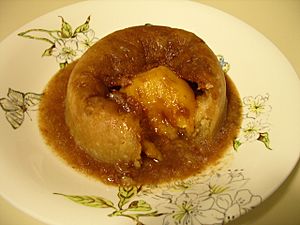Sussex pond pudding facts for kids
 |
|
| Alternative names | Well pudding |
|---|---|
| Type | Pudding |
| Place of origin | United Kingdom |
| Region or state | Sussex, Kent |
| Main ingredients | Suet pastry, lemon, butter, sugar |
Sussex pond pudding, also called well pudding, is a classic English dessert from the southern county of Sussex. It's made with a special pastry called suet pastry, filled with lots of butter and sugar. This pudding is then boiled or steamed for several hours until it's cooked. Today, many recipes include a whole lemon baked inside the pastry. The first time this dish was written about was in Hannah Woolley's book, The Queen-Like Closet, way back in 1672.
This rich and heavy pudding became less popular over time, maybe because people started thinking more about healthy eating. However, famous British chef Heston Blumenthal has helped bring it back as part of his effort to revive old British dishes.
Some versions of the pudding include currants (small dried grapes). In Sussex, this version was once called "Blackeyed Susan." In Kent, it's known as "Kentish well pudding." A recipe for this was in Eliza Acton's important 19th-century cookbook, Modern Cookery for Private Families. In East Sussex, people often just called the dish "well pudding."
How to Make Sussex Pond Pudding
When the pudding cooks, the butter and sugar inside melt and turn into a thick, sweet, caramelized sauce. When you serve the pudding and cut into it, this sauce flows out and collects on the plate, looking like a "pond." If you include a lemon, its skin almost turns into a sweet, marmalade-like candy after cooking for so long. This happens because of the lemon's own juices mixing with the butter and sugar.
Just like other suet puddings, traditional recipes use beef suet to make the pastry. However, you can also use vegetable shortening or even cold butter to get similar results.
For the best flavor, it's good to use thin-skinned, juicy lemons that haven't been waxed.
History of the Pudding
The very first recipe for Sussex pond pudding was found in Hannah Woolley's book, The Queen-Like Closet, published in 1672. It was simply called "a Sussex pudding." This early recipe used a pastry made richer with egg, wrapped around a "great piece of Butter." Woolley suggested adding sugar and rosewater only after the pudding was cooked and cut open. She also suggested decorating it with barberries.
In the 1700s, a shopkeeper and diarist from Sussex named Thomas Turner wrote about eating "butter pond pudding." He even complained about how much butter it contained! He also mentioned eating pond pudding with currants. It seems that at this time, the pudding was not made with a lemon. Older cookbooks, like Woolley's, didn't include a lemon at all.
A recipe found by Florence White, and included in her 1932 book Good Things in England, was based on one from 1905. It was made by an old woman in the village of Westham:
Make a good suet crust, put in some currants, and a little sugar.
Divide in two and roll each piece into a rather thick round. Put into the middle of one round a ball of butter mixed with sugar, using the proportions of a 1/2 lb. butter to 1/4 lb. demerara sugar. Gather up the edges of the crust, and enclose the butter ball securely by covering the join with the second round crust and pinching that up.
Put into a floured cloth, tie up rather tightly and boil 3 hours or more according to size.—Florence White
In 1939, journalist Reginald Pound described "my native Sussex pond pudding" as being "made of crust, brown sugar and butter." He didn't mention lemons either. The first time a recipe for Sussex pond pudding included a whole lemon was in Jane Grigson's book English Food (1974). Grigson believed that the slight bitterness of the lemon made the dish much better. She even said that versions without the lemon were "not worth bothering about."
In her book A History of English Food, Clarissa Dickson Wright explained that making this pudding needs "considerable flair." She meant that the cook needs skill to gently scratch the lemon so that its flavors burst out while it's cooking.
See also
 In Spanish: Pudín de estanque de Sussex para niños
In Spanish: Pudín de estanque de Sussex para niños


